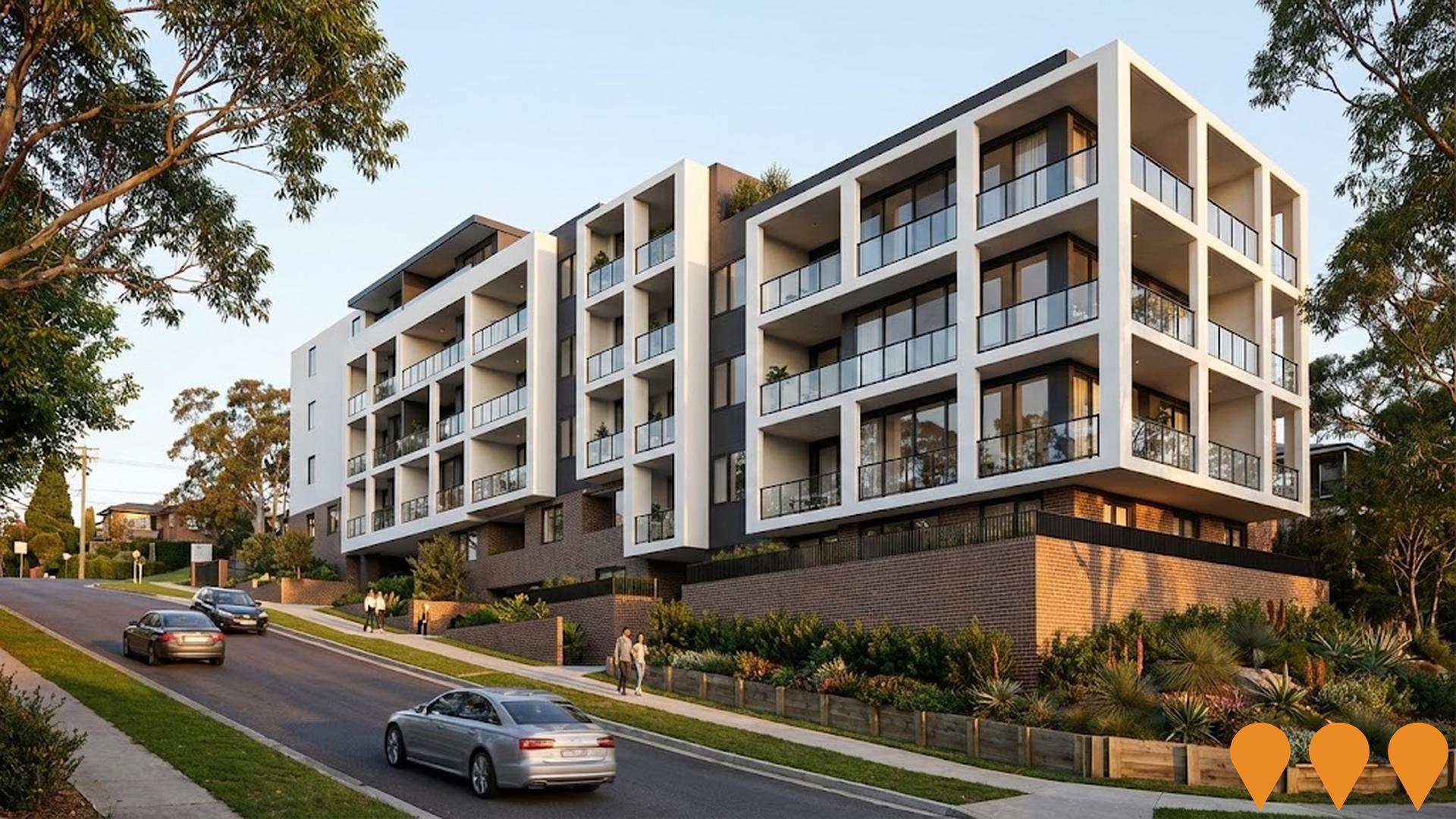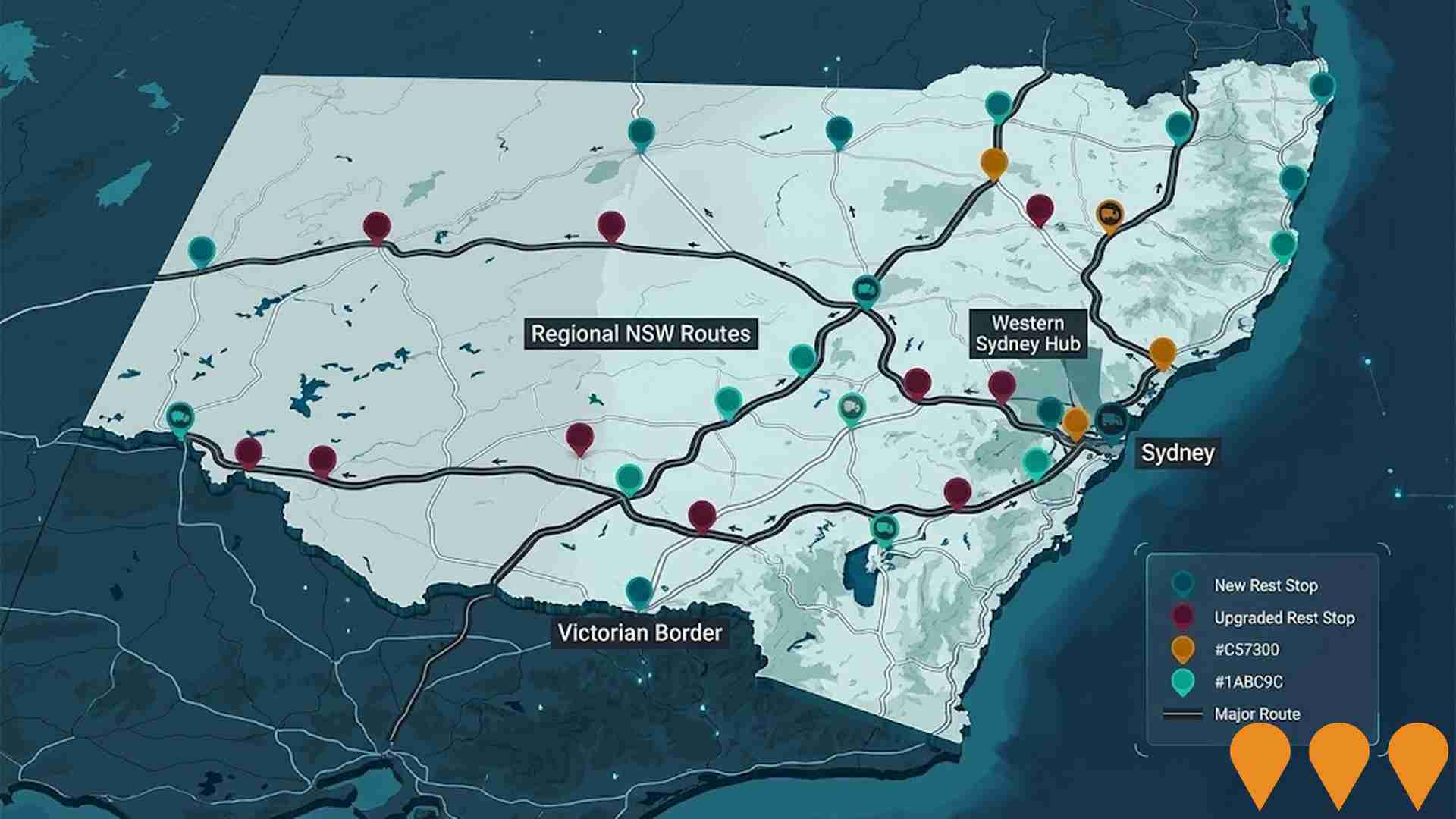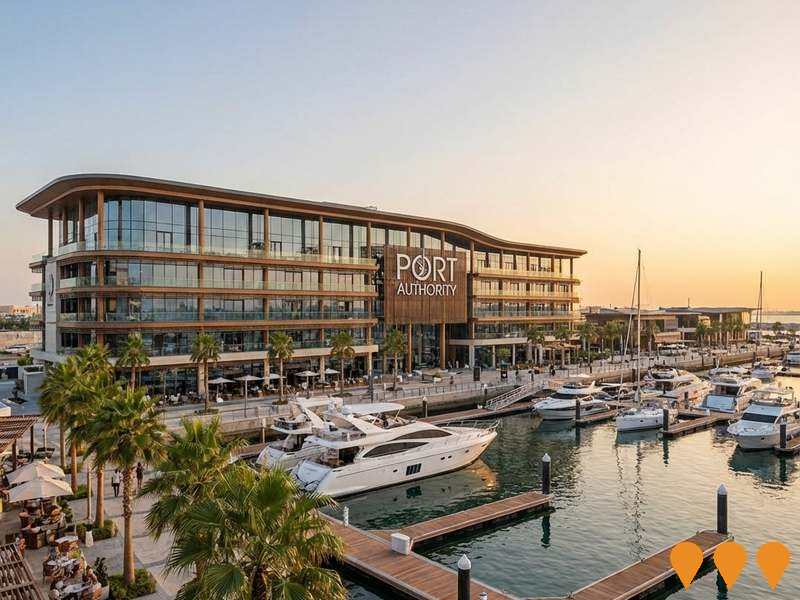Chart Color Schemes
est. as @ -- *
ABS ERP | -- people | --
2021 Census | -- people
Sales Activity
Curious about local property values? Filter the chart to assess the volume and appreciation (including resales) trends and regional comparisons, or scroll to the map below view this information at an individual property level.
Find a Recent Sale
Sales Detail
Population
Population growth drivers in Batemans Bay are strong compared to national averages based on AreaSearch's ranking of recent, and medium to long-term trends
Batemans Bay's population was approximately 8,700 as of August 2025. This figure shows an increase of 119 people from the 2021 Census count of 8,581. The change is estimated by comparing the resident population of 8,672 in June 2024 and adding 94 new addresses since the Census date. The population density is around 136 persons per square kilometer. Over the past decade, Batemans Bay has had a compound annual growth rate of 1.0%, outperforming its SA3 area. Interstate migration contributed approximately 68.7% to recent population gains.
AreaSearch uses ABS/Geoscience Australia projections for each SA2 area, released in 2024 with a base year of 2022. For areas not covered by this data, NSW State Government's SA2 level projections from 2022 with a base year of 2021 are used. Growth rates by age group are applied to all areas for years 2032 to 2041. By 2041, Batemans Bay is projected to have an above median population growth of national non-metropolitan areas, increasing by 18.5% from the latest numbers to reach a total of 10,354 persons.
Frequently Asked Questions - Population
Development
AreaSearch analysis of residential development drivers sees Batemans Bay recording a relatively average level of approval activity when compared to local markets analysed countrywide
Batemans Bay approved approximately 44 dwellings annually over the past five financial years, totalling 224 homes. As of FY-26, 14 approvals have been recorded. On average, 1.6 people moved to the area per dwelling built between FY-21 and FY-25, indicating balanced supply and demand conditions. However, this figure decreased to 0.1 people per dwelling over the past two financial years, suggesting more balanced supply conditions recently. The average construction value of development projects was $634,000, slightly above the regional average.
In FY-26, commercial development approvals totalled $85.2 million, reflecting strong commercial development momentum in the area. Batemans Bay maintains similar construction rates per person compared to the Rest of NSW, preserving market balance consistent with the broader region. New building activity comprised 70% standalone homes and 30% attached dwellings, maintaining the area's low density nature while attracting space-seeking buyers.
With approximately 337 people per approval, Batemans Bay reflects a low-density population. Population forecasts project an increase of 1,607 residents by 2041, with development keeping pace with projected growth, although increasing competition among buyers is expected as the population expands.
Frequently Asked Questions - Development
Infrastructure
Batemans Bay has moderate levels of nearby infrastructure activity, ranking in the 44thth percentile nationally
Changes to local infrastructure significantly impact an area's performance. AreaSearch identified eight projects likely affecting this region. Notable ones are Batemans Bay Community Health Facility, 24 Beach Road Residential Development, Batemans Bay Dredging, and 3 Clyde Street Mixed Use Tourist, Residential & Retail Development. The following list details those most relevant.
Professional plan users can use the search below to filter and access additional projects.
INFRASTRUCTURE SEARCH
 Denotes AI-based impression for illustrative purposes only, not to be taken as definitive under any circumstances. Please follow links and conduct other investigations from the project's source for actual imagery. Developers and project owners wishing us to use original imagery please Contact Us and we will do so.
Denotes AI-based impression for illustrative purposes only, not to be taken as definitive under any circumstances. Please follow links and conduct other investigations from the project's source for actual imagery. Developers and project owners wishing us to use original imagery please Contact Us and we will do so.
Frequently Asked Questions - Infrastructure
Low and Mid-Rise Housing Policy
State-wide NSW planning reforms via amendments to the State Environmental Planning Policy to enable more diverse low and mid-rise housing (dual occupancies, terraces, townhouses, manor houses and residential flat buildings up to 6 storeys) in well-located areas within 800 m of selected train, metro and light-rail stations and town centres. Stage 1 (dual occupancies in R2 zones statewide) commenced 1 July 2024. Stage 2 (mid-rise apartments, terraces and dual occupancies near stations) commenced 28 February 2025. Expected to facilitate up to 112,000 additional homes over the next five years.

NSW Heavy Vehicle Rest Stops Program (TfNSW)
Statewide Transport for NSW program to increase and upgrade heavy vehicle rest stopping across NSW. Works include minor upgrades under the $11.9m Heavy Vehicle Rest Stop Minor Works Program (e.g. new green reflector sites and amenity/signage improvements), early works on new and upgraded formal rest areas in regional NSW, and planning and site confirmation for a major new dedicated rest area in Western Sydney. The program aims to reduce fatigue, improve safety and productivity on key freight routes, and respond to industry feedback collected since 2022.

Batemans Bay Community Health Facility
New purpose-built community health facility offering various healthcare services including allied health, Aboriginal health, community mental health, drug and alcohol, child, youth and family services, primary healthcare, consultation, treatment, pathology, group rooms, and a gymnasium. The facility will bring together a range of services in one location including women's health and mental health services.

24 Beach Road Residential Development
DA approved residential development site with an existing motel offering holding income. Proposed for 34 apartments with unobstructed views, designed for building efficiency. Waterfront locale.

Batemans Bay Dredging
Regular dredging of the Clyde River Bar to maintain safe vessel movement, improve navigation, and support local businesses, tourism, and the economy. Includes removing approx. 30,000 cubic metres of sand and placing it in water to nourish nearby beaches.

3 Clyde Street Mixed Use Tourist, Residential & Retail Development
Proposed hotel/serviced apartment, permanent residential apartment, and retail development in two, 4 and 5 level buildings. Comprises 46 hotel rooms/serviced apartments, 10 permanent residential apartments, 2 ground level retail tenancies, and on-site parking.

The Sebel Hotel
Replacement of the Batemans Bay Hotel with a four-storey hotel and luxury apartments, including more than 70 hotel rooms, 11 luxury three-bedroom townhouse apartments, a gym, breakfast room, business centre, and 72 carparking spaces.

Batemans Bay Bridge Replacement Project
Replacement of the old Batemans Bay Bridge with a new four-lane bridge including a pedestrian and cyclist shared pathway, upgraded roundabout, and improved local road and pathway connections. It also included upgraded foreshore areas.

Employment
Employment conditions in Batemans Bay face significant challenges, ranking among the bottom 10% of areas assessed nationally
Batemans Bay has a diverse workforce with both white and blue collar jobs, prominently featuring tourism and hospitality sectors. Its unemployment rate is 6.9%.
As of June 2025, 3,307 residents are employed while the unemployment rate stands at 10.2%, which is 6.5% higher than Rest of NSW's rate of 3.7%. The leading employment industries among residents include retail trade, health care & social assistance, and construction. Notably, retail trade employs a significant share of the local workforce, at 1.5 times the regional level. Conversely, agriculture, forestry & fishing employs only 1.6% of local workers, lower than Rest of NSW's 5.3%.
Many residents commute elsewhere for work, as indicated by Census data. Between June 2024 and June 2025, Batemans Bay's labour force decreased by 3.6%, accompanied by a 4.7% decrease in employment, leading to an unemployment rate increase of 1.1 percentage points. In contrast, Rest of NSW saw employment contract by 0.1%, the labour force grow by 0.3%, and unemployment rise by 0.4 percentage points. Jobs and Skills Australia's national employment forecasts from May 2025 project a 6.6% expansion in national employment over five years and 13.7% over ten years, with varying growth rates across industry sectors. Applying these projections to Batemans Bay's employment mix suggests local growth of approximately 6.3% over five years and 13.0% over ten years.
Frequently Asked Questions - Employment
Income
Income metrics place the area in the bottom 10% of locations nationally according to AreaSearch analysis
AreaSearch's aggregation of ATO data for financial year 2022 shows Batemans Bay had a median taxpayer income of $40,638 and an average income of $50,461. Nationally, the averages were $49,459 and $62,998 respectively in Rest of NSW. By September 2025, estimated incomes would be approximately $45,762 (median) and $56,824 (average), based on a 12.61% Wage Price Index growth since financial year 2022. Census 2021 income data places Batemans Bay between the 8th and 11th percentiles nationally for household, family, and personal incomes. The largest income bracket in Batemans Bay is $800 - $1,499 weekly, comprising 30.1% of residents (2,618 people), differing from broader areas where the $1,500 - $2,999 category predominates at 29.9%. Housing affordability pressures are severe in Batemans Bay, with only 83.2% of income remaining, ranking at the 10th percentile nationally.
Frequently Asked Questions - Income
Housing
Batemans Bay is characterized by a predominantly suburban housing profile, with a higher proportion of rental properties than the broader region
Batemans Bay dwelling structure, as per the latest Census, consisted of 75.6% houses and 24.4% other dwellings (semi-detached, apartments, 'other' dwellings). In comparison, Non-Metro NSW had 84.3% houses and 15.7% other dwellings. Home ownership in Batemans Bay was at 44.4%, with the rest mortgaged (24.2%) or rented (31.4%). The median monthly mortgage repayment was $1,519, higher than Non-Metro NSW's average of $1,517. Median weekly rent in Batemans Bay was $330, compared to Non-Metro NSW's $320. Nationally, Batemans Bay's mortgage repayments were lower at $1,519 versus the Australian average of $1,863, and rents were also lower at $330 compared to the national figure of $375.
Frequently Asked Questions - Housing
Household Composition
Batemans Bay features high concentrations of lone person households, with a fairly typical median household size
Family households constitute 64.4 percent of all households, including 18.0 percent couples with children, 33.4 percent couples without children, and 12.1 percent single parent families. Non-family households comprise the remaining 35.6 percent, with lone person households at 32.6 percent and group households making up 3.0 percent of the total. The median household size is 2.2 people, which aligns with the average for the Rest of NSW.
Frequently Asked Questions - Households
Local Schools & Education
Batemans Bay faces educational challenges, with performance metrics placing it in the bottom quartile of areas assessed nationally
The area has university qualification rates of 14.9%, significantly lower than the NSW average of 32.2%. This presents both a challenge and an opportunity for targeted educational initiatives. Bachelor degrees are most prevalent at 9.4%, followed by postgraduate qualifications (3.0%) and graduate diplomas (2.5%). Trade and technical skills are prominent, with 42.4% of residents aged 15+ holding vocational credentials - advanced diplomas at 10.2% and certificates at 32.2%.
A substantial 24.7% of the population is actively pursuing formal education, including 9.7% in primary, 7.1% in secondary, and 1.8% in tertiary education. Batemans Bay Public School serves the local community with an enrollment of 483 students. The area offers varied educational conditions, with 1 school focusing exclusively on primary education and secondary options available in nearby areas. Local school capacity is limited at 5.5 places per 100 residents, compared to the regional average of 12.7, leading many families to travel for schooling.
Frequently Asked Questions - Education
Schools Detail
Nearby Services & Amenities
Transport
Transport servicing is moderate compared to other areas nationally based on assessment of service frequency, route connectivity and accessibility
Batemans Bay has 169 active public transport stops, all of which are bus stops. These stops are served by 41 different routes that together offer 599 weekly passenger trips. The accessibility to these services is rated as excellent, with residents on average located just 170 meters from the nearest stop.
The service frequency across all routes averages 85 trips per day, which equates to approximately three weekly trips per individual stop.
Frequently Asked Questions - Transport
Transport Stops Detail
Health
Health performance in Batemans Bay is a key challenge with a range of health conditions having marked impacts on both younger and older age cohorts
Batemans Bay faces significant health challenges, with various conditions affecting both younger and older residents. Private health cover stands at approximately 46%, covering around 4,019 people, compared to the national average of 55.3%.
The most prevalent medical conditions are arthritis (12.5%) and mental health issues (9.8%). Conversely, 58.1% of residents report no medical ailments, slightly lower than the Rest of NSW's 59.6%. As of 2021, approximately 29.7%, or 2,586 people, are aged 65 and over, compared to 31.7% in Rest of NSW. Despite this, health outcomes among seniors perform better than the general population.
Frequently Asked Questions - Health
Cultural Diversity
Batemans Bay ranks below the Australian average when compared to other local markets across a number of language and cultural background related metrics
Batemans Bay, as per the 2016 Census, had a cultural diversity below average with 84.1% of its population born in Australia. It also had 89.7% citizens and 94.4% speaking English only at home. Christianity was the predominant religion, accounting for 54.7%, compared to 49.0% across Rest of NSW.
The top three ancestry groups were English (32.2%), Australian (28.1%), and Irish (9.2%). Notably, Australian Aboriginal representation was higher at 5.9% in Batemans Bay than regionally at 3.6%. Maltese and Polish populations also showed divergence with 0.5% and 0.7%, respectively, compared to regional averages of 0.4% and 0.5%.
Frequently Asked Questions - Diversity
Age
Batemans Bay ranks among the oldest 10% of areas nationwide
Batemans Bay's median age is 51 years, significantly higher than the Rest of NSW average of 43 and considerably older than Australia's median age of 38. Compared to the Rest of NSW average, those aged 65-74 are notably over-represented in Batemans Bay at 16.1%, while those aged 25-34 are under-represented at 8.9%. The 65-74 age group is well above the national average of 9.4%. According to post-2021 Census data, the 35-44 age group has grown from 9.2% to 10.3%, while the 65-74 cohort has declined from 17.3% to 16.1%. By 2041, Batemans Bay's population is expected to see notable shifts in its age composition. The 35-44 age group is projected to grow by 31%, reaching 1,174 people from the current 894. Meanwhile, the 15-24 cohort grows by a modest 2%.
